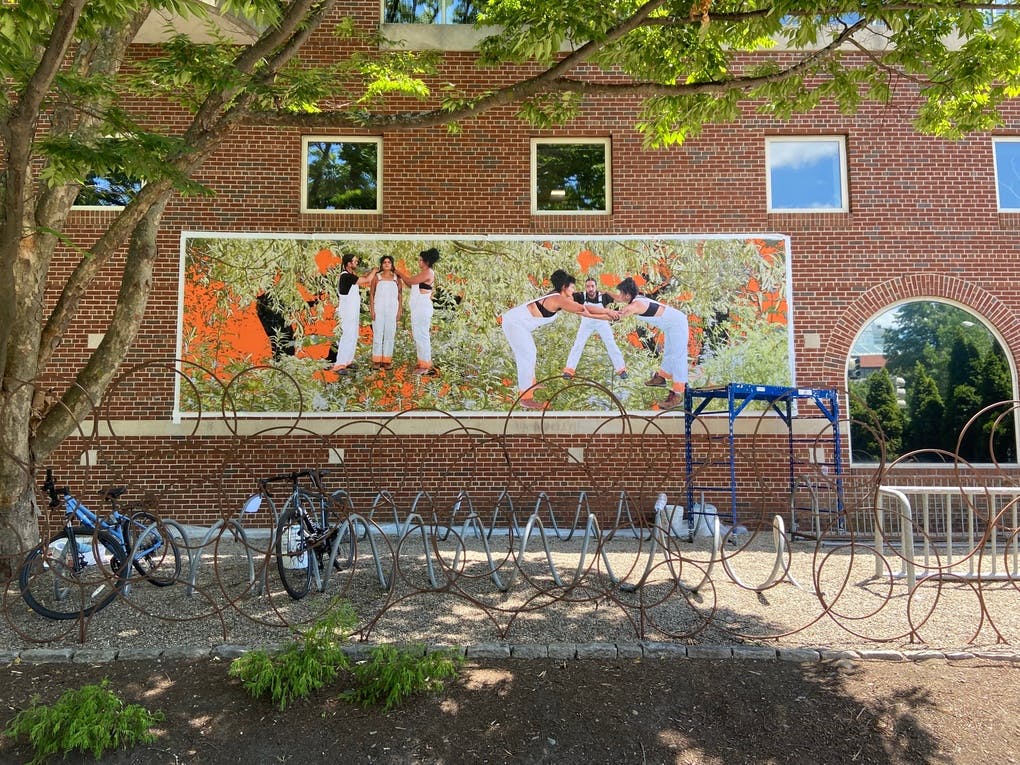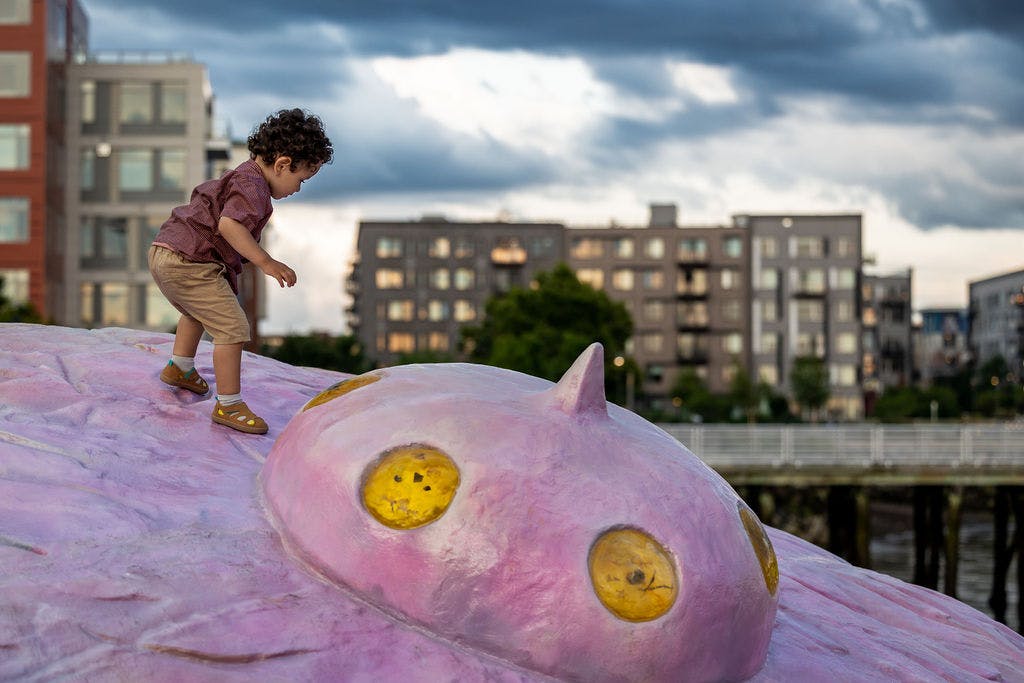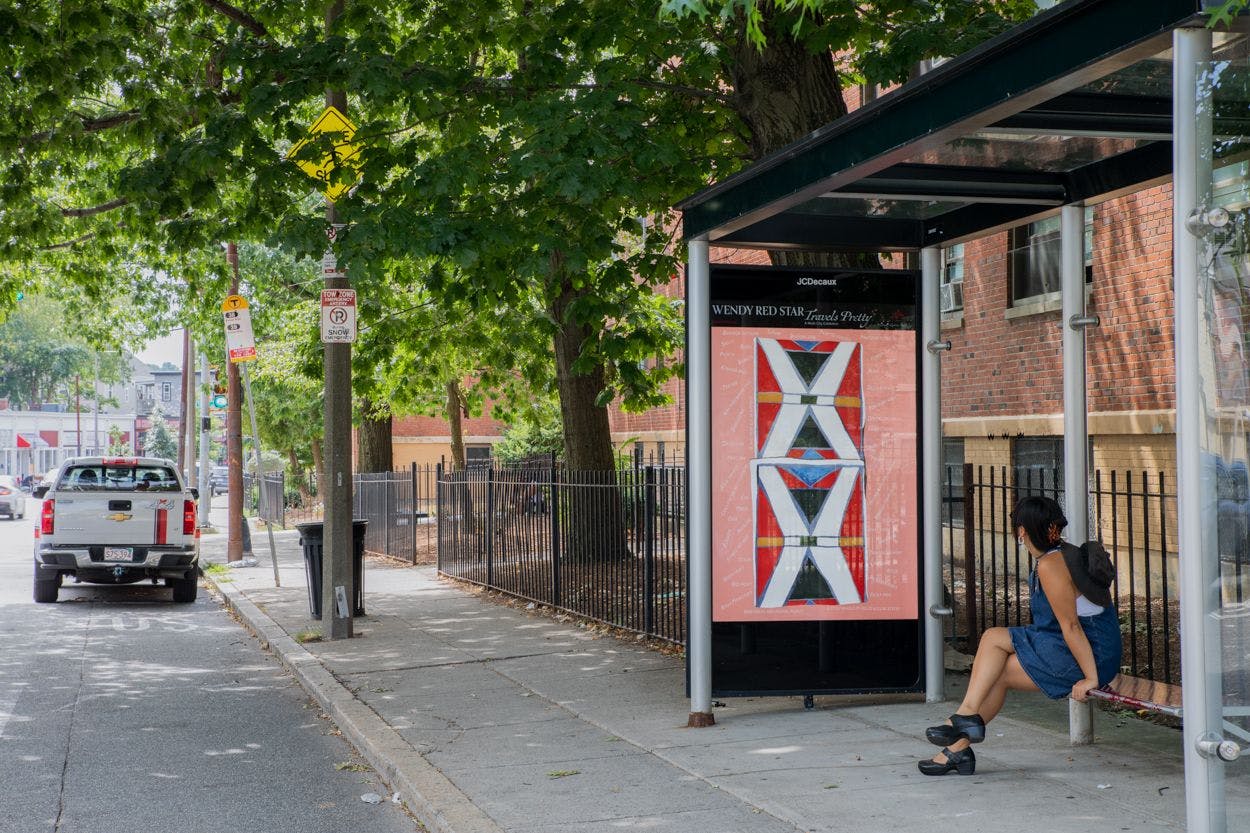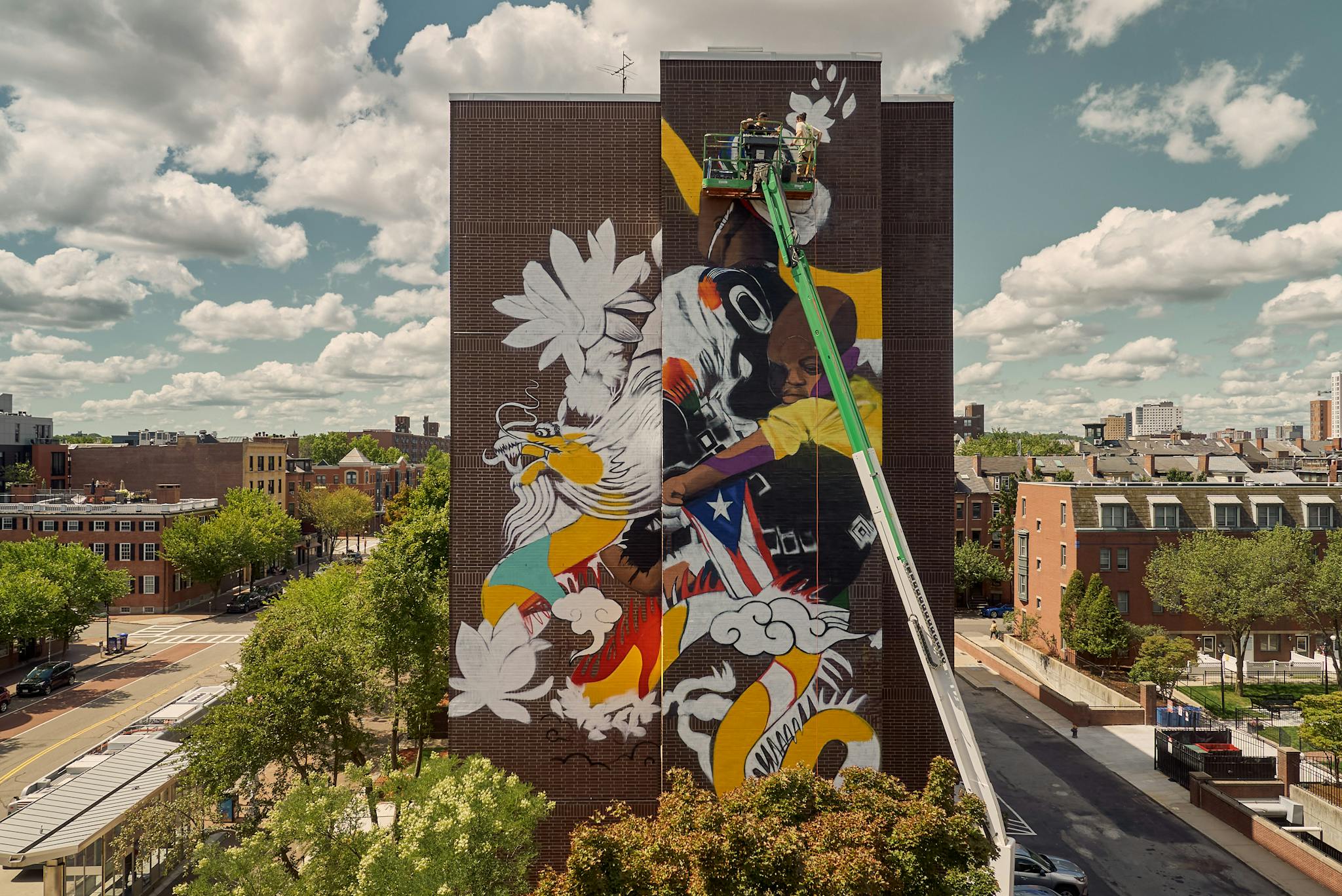At its best, public art offers so much to our communities. It amplifies the work of (often local) artists. It celebrates or elevates the concerns of the communities in which it resides. And, for many city travelers, it offers an unexpected surprise, a bit of magic and meaning that disrupts the humdrum of the everyday. What may not always be visible, however, is that this one bright moment requires a gargantuan amount of effort to pull off. Years of planning and permitting, teams of fabricators and art assistants and project managers, months of zoning board hearings and community meetings mean that public art creation remains the purview of the well funded, the especially well organized, or the incredibly tenacious (think the Black Lives Matter mural effort in Nubian Square).
As the summer comes to a close, the artists who have been hard at work in the heat are packing up their materials. Our editors have selected eight public art projects you can check out now (or very soon) here in Boston. From vibrant murals to a UFO crash landing to sites for sharing poetry, these community-focused projects are sure to keep you exploring the great urban outdoors well into the fall. You can see all of the destinations included in this roundup on our handy map below and check back in throughout the season as we add new additions.
Mysteries and Monsters Take Over the Emerald Necklace with Boston Cyberart’s “ALPHA 60” AR exhibit

Chris Rackley, Monopters at the Gate, still, 2022. Augmented Reality animation, 01:00 minutes with audio, looped. Photo courtesy of Boston Cyberarts.
In Jean Luc-Godard’s 1965 sci-fi flick Alphaville, ALPHA 60 is a croaky omnipotent super computer who orders the ritualized execution of any who act “illogically” via synchronized swimmer-stabbing (just go with it). The idea is that mankind has proven itself unworthy of determining its own destiny and has to hand over the reins to a more rational-minded entity. Godard, as you might expect, rejects this premise, and so does curator Michael Lewy, whose own “ALPHA 60,” a trippy, augmented reality (AR) exhibition supported by Boston Cyberarts, disrupts the monotony of our everyday environment by inserting the fantastical, disturbing, absurd, and sublime, the—in a word—irrational.
To experience it, download the Hoverlay App and cast your screen around the mapped areas of the Emerald Necklace to discover twenty-one works by nineteen artists. You’ll find pieces charged with political condemnation (Lani Asunción’s monetized pineapple eclipsing the Dole house in Jamaica Plain), works rife with personal significance (Heather Kapplow’s tribute to a childhood memory), and art that continues to riff on classic cinema (such as Tom Buckland’s homage to Méliès’s blinded moon, or the pieces by many artists making more explicit references to Alphaville). Many of the works incorporate sound and movement; all are disarming.
As with all outdoor public art, the conditions of the particular day inform your experience of the work. When I took my own excursion around Jamaica Pond, it was bright and sunny, a breezy seventy-five degrees, and the creatures I encountered felt like welcome visitors; I can imagine the experience could be eerie in other weathers. But that’s part of the magic. As Godard’s ALPHA 60 asserts: “No one has ever lived in the past. No one will ever live in the future. The present is the form of all life.” With this project, Lewy is injecting a poetic antidote to keep that present alive.
“ALPHA 60,” curated by Michael Lewy and presented by Boston Cyberarts, will be on view until September 30.
–Jessica Shearer
Vibrant Murals Honoring Community by Rixy and Marka27 Land in Allston and the South End

Rixy, Rita’s Spotlight, 2022. Photo by Lee Hopkins courtesy of Mayor’s Office of Arts and Culture.
As part of the Transformative Public Art Program launched by the City of Boston in 2019, murals and temporary public art installations are offering sites for dialogue and celebration. Over forty short- and long-term public art projects received funding in the 2021 cohort, with major mural projects just starting to crop up around the city.
In Allston, artist Rixy was commissioned to create a mural that honors the life of Rita Hester, a Black trans woman who was a beloved community member in Allston. Her death was the result of anti-trans violence in 1998, and in November of 1999, activists organized the first Transgender Day of Remembrance in Hester’s honor. The mural was first proposed by Boston Artist in Residence Golden, who suggested a mural to honor the legacy of Rita Hester in the neighborhood she loved. Rixy’s response to the call was designed based on conversations with members of Hester’s family, community groups, and local trans advocacy organizations. The resulting portrait, titled Rita’s Spotlight, features Hester with glowing pearls adorning her neck, a feather boa around her shoulders, and—in Rixy’s classic feline touch—hands rendered in cheetah print. Recently unveiled at 506 Cambridge Street in Allston, the mural features a line from one of Hester’s poems that reads “Look to me my family” and calls onlookers into her light.
In the South End, another bright wall is well underway on the exterior of the Washington Manor apartment complex. Eighty-five feet tall, the towering mural will show a small child swathed in colorful fabric on his mother’s back, a swirling dragon, bold lotus flowers, and cartoon clouds. It’s the work of Victor “Marka27” Quiñonez, the co-founder of Street Theory who has left his mark on Boston with murals that pull from his own Mexican and Indigenous heritage while incorporating patterns, figures, and histories from cultures around the world. For SOULEDAD, Quiñonez worked with community members to develop an image that represented the rich cultural history, present, and future of the area—especially of the nearby Villa Victoria neighborhood. A Puerto Rican flag hangs from beneath the mother’s arm while cherry blossoms dance in the background. The pride, good fortune, and love can already be felt emanating from the wall.
Both murals are expected to be on view for the foreseeable future. A dedication ceremony and artist talk is planned for SOULEDAD in October. View the full list of projects in the Transformative Public Art initiative.
—Jameson Johnson
Sofía Córdova’s Billboard Contends with Crises through Creativity

Installation view: Sofía Córdova, A Touch Could Be The Spark, How Will I Recognize You? (Braid & Huddle, Billboard), 2022. Wheatpaste inkjet print on wood panel. Photo courtesy of Tufts University Art Galleries / SMFA at Tufts.
Puerto Rican-born, Oakland-based artist Sofía Córdova is taking over the SMFA at Tufts. Greeting visitors via billboard outside of the SMFA building entrance, A Touch Could Be The Spark, How Will I Recognize You? (Braid & Huddle, Billboard) was commissioned to coincide with Córdova’s solo exhibition at the SMFA, “Backed Up Into Dawn.” While the show will run from August 30 to October 23, A Touch Could be the Spark will be up through August 2023.
Córdova’s work explores science fiction and speculative histories, as well as the interconnectedness of the climate crisis, colonialism, and capitalism. Like much of her work in various other media, A Touch Could Be The Spark plays with the idea of our current reality, making the viewer question the relationships depicted within. In this case, Córdova features herself as well as dancer collaborators Rashaun Mitchell and Meg Jala in two different positions of connection against a distorted landscape. The compositions are curious, like part of a dance. I’m excited to see how this theme ties into “Backed Up Into Dawn,” which will feature video work.
And luckily, the longevity of the installation means that even once “Backed Up Into Dawn” closes, we’ll still have Córdova’s presence in Boston—at least for a year.
Sofía Córdova’s billboard, A Touch Could Be The Spark, How Will I Recognize You? (Braid & Huddle, Billboard), will be on view at SMFA at Tufts until August 30, 2023.
–Karolina Hać
Now + There’s Accelerator Artists Launch Projects from East Boston to Nubian Square

A child plays on Eli Brown’s installation Beam Me Down (2022) in LoPresti Park, East Boston. Courtesy of Now + There. Photo by Caitlin Cunningham Photography LLC.
Now in its fourth year, the Now + There Accelerator Program ushers early- to mid-career artists through the process of creating new, temporary public artwork across Boston. Projects by interdisciplinary artists Eli Brown and Rhea Vedro delight the spirit and invite communal reflection while upcoming mural projects by Karmimadeebora “Mima” McMillan and Rixy will enliven Nubian Square and Roxbury respectively.
On view through January 2023, Eli Brown’s Beam Me Down can be found at LoPresti Park in East Boston. The purple orb sits by the river like a playground structure—or a fallen UAP (unidentified aerial phenomenon)—or an emerging creature. Its ambiguity mystifies, but Brown refers to it as a “time-ship.” If you look closely, you will find portholes containing fossils of local tidal animals. Brown’s practice engages with queer temporalities—flexible, non-linear ways to perceive time. Beam Me Down is an opportunity to time travel—to touch fossilized ancestors and imagine distant, indiscernible horizons. The sculpture is accompanied by a zine that expands the piece’s narrative, explaining the adaptation and survival lessons we can learn from hermaphroditic creatures amidst a climate crisis.
Rhea Vedro creates a ceremony. Her multi-phased Amulet is a community metal-smithing project. In Phase 1, Vedro led “Wishmark Workshops” in which she asked participants to imagine a safe passage for themselves or a loved one and to stamp this intention into metal. Vedro will gather these pieces into a community amulet at Boston City Hall Plaza’s North Entrance this fall. Vedro’s project is an act of collectivism steeped in the resonant presence of its multiple makers.
Murals from Rixy and Karmimadeebora “Mima” McMillan will be unveiled later this fall. In Roxbury, Rixy will create Pa*Lante—a dynamic image of a Latinx woman and her feline sidekick. Rixy’s figures are brought to life by their fierce postures, storied atmospheres, and an electric purple-y glow. Mima McMillan’s 70-foot mural Ms. Merri Mack’s Journey Through Nubian Square/From Pain to Power/Uplifting the Black Community is planned for Nubian Square. Ms. Merri Mack is a recurring character found in other pieces by McMillan—some of which are currently on view in the Project Room inside the Mills Gallery at Boston Center for the Arts through September 10. Ms. Merri Mack’s name comes from a character in a nursery rhyme believed to have been sung initially by enslaved children in the United States, now popular throughout many English-speaking countries. McMillan’s paintings give her protagonist a fantastical stage, a sort of wonderland, transforming pain and propaganda into autonomy and power.
Now + There’s Cohort Four Accelerator Artists will have projects on view throughout the city for the remainder of the year.
–Maya Rubio
Wendy Red Star’s “Travels Pretty” Brings Art Along for the Ride

Wendy Red Star, Brings Together, 2022. Acrylic, digital print. Courtesy of the artist. Artwork part of “Wendy Red Star: Travels Pretty,” presented in Boston by Public Art Fund on 300 JCDecaux bus shelters across New York City, Boston, and Chicago, on view August 10–November 20, 2022. Photo: Mel Taing, Courtesy of Public Art Fund, NY.
I’m a fan of public art for public transit. Not only does it beautify an otherwise utilitarian space, it enlivens what can be a dull, somnambulant process. Here, art gives us something to do and feel: to ponder, appreciate, marvel at, or—in the case of Wendy Red Star’s vivid, evocative paintings—all of the above. Her first public art project, “Travels Pretty,” is a series of twelve acrylic works that are presented on JCDecaux bus shelters around Boston, as well as New York City and Chicago. Each depicts a parfleche, a richly decorated traveling container used by nomadic Native American tribes to store sustenance and spiritual objects during long journeys.
Crafted by women, parfleches are rawhide vessels—typically envelopes—brightly painted with geometric symbols. In this project, Red Star draws on her long practice of mining archives to offer her own interpretations of parfleches fashioned by the Apsáalooke (Crow) tribe—Red Star’s own. They often feature triangle and hourglass shapes outlined in tapering bands of brilliant blue, which both encapsulate the design and seem to erupt beyond it. The pieces are brimming with historical significance; each parcel is inspired by a real, museum-housed parfleche, surrounded by tantalizing words and phrases related to the production of the original, and titled after actual Apsáalooke women found in the 1885 Crow Census.
Keep an eye out during your commute and you’ll catch works like Ties Up Her Bundles, with a vibrantly patterned bag inspired by a nineteenth-century parfleche in Harvard’s Peabody Museum, or—my personal favorite—The Ground Is Her Medicine, which features the meticulous, incised mark making that details a circa-1850 container in the Field Museum in Chicago.
We go to art to be, as Seamus Heaney puts it, “forwarded within ourselves.” In this case, the art has come to us, and we are traveling along together, inside and out. With Red Star’s generous project, we have somewhere sacred to put the progress.
Wendy Red Star’s “Travels Pretty” project, presented by Public Art Fund, will be on view throughout the city until November 20, 2022.
–Jessica Shearer
Olmsted Now Enlivens the Emerald Necklace with Art and Engagement

On August 6, Dzidzor Azaglo and Crystal Bi presented an early version of “Wilderness Project” at Carson Beach as a part of the Asian American Resource Workshop Summer Celebration. Photo by Rene Dongo.
April 26, 2022 marked the two hundredth anniversary of Frederick Law Olmsted’s birthday. The landscape architect, journalist, and social advocate is best known for designing Central Park, but here in Boston—where his first design firm was based—we know him for masterminding Boston’s green space. The stretch from Boston Common to Franklin Park connected by what Olmsted called a “green ribbon” and we affectionately call the Emerald Necklace today has become the site of an extended birthday celebration. In lieu of a singular bicentennial celebration, the Emerald Necklace Conservancy has launched Olmsted Now, a multi-year initiative aimed at reconsidering how the park system can be a more equitable and nature-filled site for our community to share space, ideas, and time.
The programming is decentralized; events have occurred inside the park and virtually while digital platforms have become a site for sharing stories and scholarship. Earlier this summer, Olmsted Now awarded sixteen projects driven by local artists and creatives with a Parks Equity & Spatial Justice Grant to produce physical sites for community engagement across ten different Boston neighborhoods. Recipients have a relatively quick turnaround to produce their projects as the bicentennial celebration will wrap up as the weather cools at the end of October.
While many projects will gather community around a particular event, Dzidzor Azaglo’s and Crystal Bi’s Wilderness Project, on view at Overlook Ruins at Franklin Park from September 30 through October 7, will be a temporary public art installation that invites visitors to share prayers and proverbs along a structure made from Asiatic bittersweet vines. The artists have shared previews and tests of this project, but we’re eager to see how it comes to fruition alongside programs that weave in music, dance, poetry, spirituality, and nature.
Keep an eye out for additional program announcements. From taiko in the parks to Ifé Franklin’s processional honoring the ancestral spirits of African Americans enslaved in Boston, these proposals offer points of entry for engaging with public space that celebrate all parts of Boston—not just the neighborhoods that touch the park system.
Olmsted Now will hold projects and events featuring numerous artists, community organizers, and activists through October 2022.
—Jameson Johnson
Agnieszka Kurant Illuminates Communality at MIT

Installation view: Agnieszka Kurant, The End of Signature, 2021 and 2022. Collaboration with Katie Lewis, Divya Shanmugam, Jose Javier Gonzalez Ortiz and Professor John Guttag. MIT Collection Commissioned with MIT Percent-for-Art funds. Photo by Charles Mayer Photography.
Artist Agnieszka Kurant is a big believer in teamwork—she once even enlisted a colony of termites as artistic collaborators. Her massive light sculptures The End of Signature (2021 and 2022), two recent additions to MIT’s public art collection, continue her exploration of collective intelligence and creativity—timely terrain in an era in which scientific progress (like the rapid development of Covid vaccines) is increasingly achieved by big teams and many artists execute projects with the help of large staffs of assistants (whose labor often goes uncredited).
Working with MIT doctoral students Katie Lewis, Divya Shanmugam, and Jose Javier Gonzalez Ortiz and Professor John Guttag, Kurant used artificial intelligence to create two collective signatures. Their algorithm averaged the John Hancocks of scientists, academics, students, and interns working in MIT’s Building E37 and also combined signatures collected from nearby Cambridge residents. The resulting sculptures—one a neon scrawl, the other an animated LED scribble—will be dedicated on September 13, when Kurant will appear at the MIT Welcome Center Auditorium for a 6 pm lecture, followed by a 7 pm celebration beneath the glowing sculptures.
Registration is free here, but if you can’t make it in person, you can catch the lecture on live video stream and keep an eye out for Agnieszka Kurant: Collective Intelligence, a book exploring the past decade of the artist’s career due in February from MIT Press.
Agnieszka Kurant’s light sculptures The End of Signature (2021 and 2022) are on view at MIT’s Graduate Tower at Site 4 (Building E37) and Site 3 (238 Main Street). Dedication ceremony to be held September 13.
—Jacqueline Houton
Care and Community at the Rose Kennedy Greenway

Erin Genia with her installation Tuȟmaǧatip (2022). Clay, natural composite materials, driftwood, gourd, bamboo, pipestone pigment. Courtesy of the Rose Kennedy Greenway. Photo by Audrey Lopez.
This season, public art of the Greenway is all about caring for yourself, your community, and mother nature. The projects revolve around making environments for rest, strengthening community bonds, and building upon what earth has already given.
Mithsuca Berry’s series of illustrations and texts—Where The Land And Our Bodies Intersect—can be found swaying on hanging flags near Faneuil Hall, making space to recharge. Self-care is shown through the imagery of figures entangled with growing plants, backgrounds of glowing skies, and an acknowledgment through text of existing. The warm and cool hues vibrate against one another and evoke emotions of happy relief, allowing the viewers to feel the sunshine and breathe the fresh air.
In the Rose Kennedy Greenway’s Wildflower Meadow, Erin Genia purposely utilizes the undeveloped site for her installation Tuȟmaǧatipi. While most of the Greenway has maintained lawns to walk on, the Wildflower Meadow allows plants to (over)grow and fill the space. This area of the Greenway already supports local bees, butterflies, and moths. With Tuȟmaǧatipi, named for the Dakota word for beehive, Genia hopes to help support that ecosystem. An integration of form and function, the sculpture is made from sustainable materials such as clay and bamboo and follows the Dakota morning star form as reference to Indigenous occupied lands. The sculptural habitat provides rest for native pollinators, enabling them to thrive in the middle of the city.
Seeds of Love and Justice is an extension of Ekua Holmes’s ongoing Roxbury Sunflower Project. The sunflowers are a symbol for Roxbury, exemplifying the care and love put back into the neighborhood for and from the community. Designed to grow alongside the new mural Breathe Life Together by Rob “ProBlak” Gibbs, also a Roxbury-native artist, the sunflowers draw that direct connection to the community and also nod to the growth and nurturing needed to engage the next generation.
Mithsuca Berry’s Where The Land And Our Bodies Intersect and the multi-artist work Seeds of Love and Justice will be on view through September 2022. Erin Genia’s Tuȟmaǧatip will be on view through December 2022, and Rob “ProBlak” Gibbs’s Breathe Life Together will be on view through May 2023.
—Kaitlyn Ovett Clark
Kaitlyn Ovett Clark is managing editor for Boston Art Review and the exhibitions and public programs manager at the Tufts University Art Galleries at the SMFA.
Karolina Hać is an editor at Boston Art Review and head of marketing at Höweler+Yoon Architecture, LLP.
Jacqueline Houton is senior editor at Boston Art Review and a copyeditor at Candlewick Press.
Jameson Johnson is editor-in-chief at Boston Art Review and marketing and development manager at MIT List Visual Arts Center.
Maya Rubio is an editor at Boston Art Review, an independent curator, and a project assistant at art_works.
Jessica Shearer is an editor at Boston Art Review and director of communications and user experience at the Boston College Center for Corporate Citizenship.









